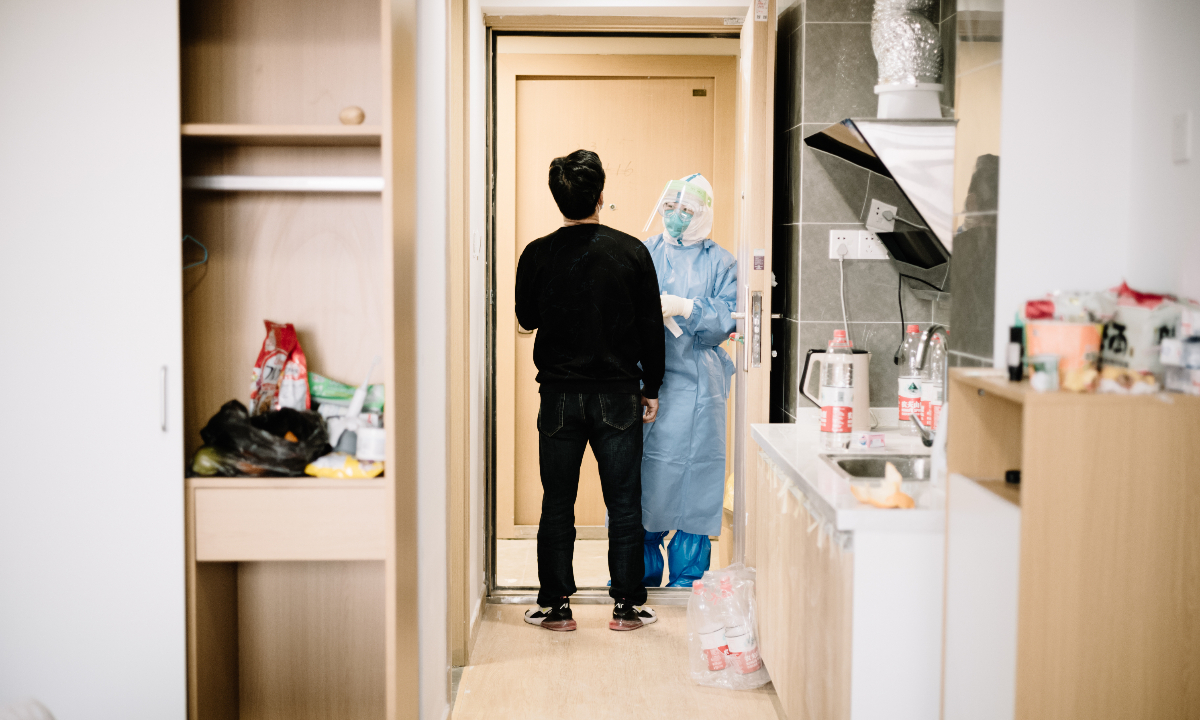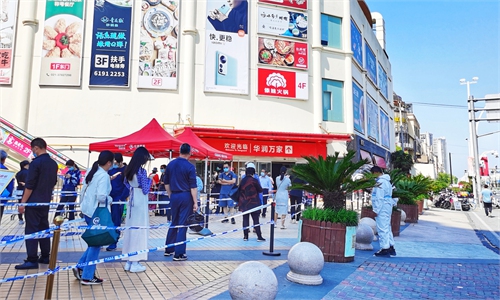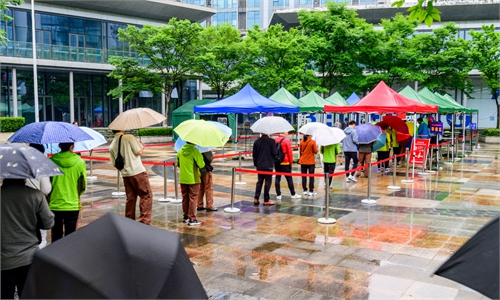Update: Shanghai refutes rumors of a person infected with COVID-19 hid in a building for 14 days

A patient takes nucleic acid test at a makeshift hospital in Shanghai. Photo: VCG
Shanghai anti-rumor platform on Tuesday refuted a rumor circulating online that the residents of a residential building in Shanghai hid a person infected with COVID-19 for 14 days.
The rumormonger, a man surnamed Lu, resident of Jiading district in Shanghai, has been educated and required by the local police to clarify the facts and apologized in the WeChat group for spreading the rumor, according to the platform.
Lu told the police he made up the gossip after reading articles circulating online about residents of a building in Shanghai that were all transferred to centralized quarantine after one case of the virus was discovered in the building.
Lu said he wanted to suggest the residents of his building that they could hide a person infected with the virus, if any was found in the building, to prevent being sent to centralized quarantine.
Video clips showing Shanghai residents from some residential buildings being required to transfer to centralized quarantine sites when positive infections discovered in their buildings have gone viral over the past few days. Shanghai's anti-rumor platform has also received a large quantity of inquiries about the necessity of quarantining all the residents once a positive case is discovered in a building.
Shanghai authorities responded to the public speculations about one positive infection in a building will result in all the residents in the whole building being centralized quarantined: whether a person is identified as first or second degree close contact is a holistic judgment made by epidemiological professionals according to national standards, with consideration for the results of epidemiological investigations and information from big data screening, Sun Xiaodong, deputy director of Shanghai Municipal Center for Disease Control and Prevention said during a press briefing on Tuesday.
According to Sun, close contact refers to those who had been in short-distance contact with a suspected or confirmed case but have not taken effective protective measures during four days before the cases showed symptoms, or those who had been in short-distance contact without preventive measures with asymptomatic carriers during four days before the silent carriers were sampled.
Those who have possibly been exposed to polluted environment are also identified as close contacts. Second degree close contacts refer to those who live, work and study together with close contacts and have frequent contacts.
If an individual who lives in an environment with independent access to kitchen and toilet facilities tests positive, he or she will be placed under strict management (meaning the person will be confined to their home). The people living with the infected person will be considered first degree close contacts, while the people living on the same floor and on the upper and lower floors are second degree close contacts.
If a person has no independent access to kitchen and toilet facilities and tests positive, then both those who live with the infected person and those who use the same kitchen and toilet facilities will be considered first degree close contacts. Moreover, those who live on the same floor or those who live in the same house and have daily contacts with the infected person will also be identified as first degree close contacts. Those who live in the same building or the same village but not together with the infected person are second degree close contacts.
However, the aforementioned are just the criteria for judgement, the onsite investigations and the results of risk assessment will also be taken into account for the comprehensive judgement of specific cases, Sun stressed, adding that the judgment cannot be made by a simplified and one-size-fits-all approach.
Meanwhile, the necessity for environmental disinfection has also been an issue of public concern over the past few days with many questioning the need and the standardization of the procedures.
Video clips circulating on the internet alleging that home disinfection was mandatorily carried out in the community in downtown Huangpu district has caused concerns among residents.
According to thepaper.cn, the in-home disinfection was carried out after soliciting the public opinions of the local residents, and there was absolutely no forced disinfection such as breaking into the residents' homes. The disinfection was conducted by professional institutions.
Household disinfection is an important part of epidemic prevention and control, Jin Chen, deputy director of Shanghai Municipal Commission of Housing and Urban-rural Development, said during the Tuesday press briefing, saying that the CDC has formulated a series of disinfection standards and evaluation standards for the disinfection work to be carried out in the places where positive infections live.
According to Jin, despite that home disinfection meant to be carried out in positive infections' homes, one exception is that in some old compounds where positive cases share kitchens and toilets with neighbors, then neighbors' homes will also be disinfected.
Shanghai still remains at a critical stage of epidemic prevention and control with more than 2,000 new infections registered on Monday, most of whom were found in those already under quarantine, Sun said.
In terms of regional distribution, more than 90 percent of these infections were detected in downtown areas and inner suburbs in areas of older compounds and urban villages.
These densely populated areas with poor living conditions and unhygienic environments have more risk of viral spread due to sharing of kitchens and toilets.
Thus, the city has focused on the residential compounds and the public environment, organizing 160,000 personnel in the daily disinfection work in the public spaces of 13,000 compounds across the city, Jin said.


